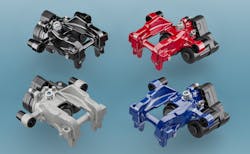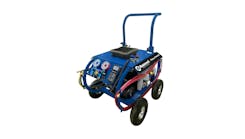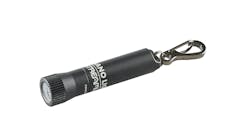This article has been updated from its original 2007 version.
For a 2023 article on the subject, please also see https://www.vehicleservicepros.com/21290213.
What you will learn:
• How the two types of Electronic Parking Brake (EPB) configurations function
• The proper tools required to safely service and repair EPBs
• How to properly service and repair a variety of different vehicle manufacturer's EPB systems
When parking a car, there are two ways to make it stay put: shift into park (or shift a manual transmission into gear) or set the parking brake. Ideally the driver will do both, but if everything is working properly, either one of these will do the job.
On most cars, there's a direct mechanical linkage between the driver and the parking brake. However, in a short-but-growing list of vehicles, an electronic control unit operates the parking brake. The driver can still apply or release the brake with a button, but these systems can also operate automatically. Some apply the brake in park; some apply the brake when the vehicle comes to a full stop, when the trunk lid is open or under several other scenarios. To unlock the brakes for service and to prevent nasty surprises while working on the vehicle, make sure your technician customers know how the control unit "thinks" and how to disable it.
Electronic parking brakes (EPB) are currently made by Continental-Teves (ATE), Aisin and TRW, and soon Siemens VDO, Bosch, Delphi and possibly others will join the market. Eventually we'll see them on almost any make of car — not just luxury models.
Because the Controller Area Network (CAN) communications bus essentially turns a vehicle into one big integrated network, we won't have long to wait. CAN is mandatory for 2008 models, and most of the wiring, sensors and switches needed for EPB already will be installed for other items. The recent development of small but powerful electric motors is the final piece that makes EPB possible.
There are two different types of EPB. One type uses a single motor to pull a cable on an otherwise conventional cable-operated parking brake system. This is used on the Lexus LS 460, Lincoln LS, Jaguar X-Type and XJ, various BMW models and most Land Rover models.
The other type has a motor on each rear caliper that mechanically operates the caliper piston. It can be found on Mercedes-Benz vehicles, Audi A6 and A8 models and the Volkswagen Passat. In each system, the control unit operates the motor in both directions as needed, just like a window lift motor. In fact, the motor itself may be exactly the same as a window lift motor but with a transmission to multiply its torque. By themselves, EPB systems are not strong enough to stop the car quickly, but they will hold it in place.
Repair and maintenance of the caliper-mounted systems is not particularly complicated, provided the tech has the right tools. However, the cable-puller systems are another story. Removing the actuator from the Jaguar XJ requires removing the fuel tank. The same job on the Lexus requires removing the rear subframe.
Even if a technician decides not to tackle these jobs, he or she still needs to know how to manipulate the system for normal maintenance procedures, such as replacing the car's battery or retrieving it from the roll-back.
Lexus LS460
Standard cable-operated drum brakes are mounted inside the hat section of the rear brake rotors. Replacement and adjustment are the same as conventional parking brakes, but you'll need to release the EPB first. A dash-mounted switch operates the EPB as follows:
With the AUTO switch ON and the ignition switch ON, the EPB will release when shifting out of park and apply when shifting into park.
With the AUTO switch OFF, the EPB can be applied by pushing and holding the parking brake switch. This will work with the ignition switch ON or OFF and with the vehicle moving or stationary.
To release the brake, pull and hold the manual switch while at the same time pressing the brake pedal.
If the BRAKE HOLD switch is ON (a separate feature not part of EPB) and the vehicle is stopped for more than three minutes, the EPB will apply if the driver's door is open, if the driver's seatbelt is unbuckled or if the hood or trunk lid is open.
If the system will not function at all, there's a manual release tool in with the spare tire tools. Remove the screwdriver blade from the handle and install the long brake release tool. Remove the access plug near the front of the spare tire well, insert the tool, engage the brake motor and "unscrew" to release the brakes.
Advise technicians to not leave the tool engaged, just in case the system runs the motor. After replacing the brake shoes, they need to be bedded in. The control unit will partially apply the brakes during a specific drive-cycle, but a scan tool is needed to activate this feature.
Land Rover
The EPB on these models uses cable-operated, drum-type parking brakes mounted inside the hat section of the rear brake rotor. Before adjusting or removing anything, the EPB must be released and disabled, and it may be necessary to slacken the parking brake star wheel adjusters to remove the rotor.
Short of disconnecting the battery, the system can be disabled by removing fuses 8E and 11E from the under-hood fuse box and/or fuses 40P and 41P from the inside fuse box. There's a manual release under the coin tray next to the shift lever. Pry the coin tray out of the console, hook the jack handle into the cable loop and pull.
The actuator is mounted above the rear axle, and removal only requires removing the EVAP canister and a heat shield.
Inside the actuator housing is the motor and transmission and a force sensor. Both brake cables are joined at the force sensor, and along with the control unit's software, this sensor is the secret of the system's operation.
How it works
- The brake is applied by pulling up on the console-mounted switch. It can be applied even with the ignition switch OFF.
- Pushing down on the switch releases the brake, but only with the ignition switch ON and the brake pedal pressed.
- The brake will also release automatically with the ignition switch ON, the transmission in gear and the driver pressing the accelerator pedal (drive-away mode).
- If the switch is held up while vehicle speed is greater than 6 mph, the control unit will send a brake-apply request to the ABS control unit and the hydraulic brakes will be applied. Once stopped, the hydraulic brakes will release and the EPB will apply to hold the vehicle.
- Depending on how the driver's preferences have been programmed, the brake may apply automatically when removing the key from the ignition switch. To override this, the brake switch down must be held down (release EPB) when removing the key.
- If the switch is operated too often in a short period of time, the system will go into a stand-by mode for about one minute to let the motor cool down.
- The control module remains "awake" for 20 minutes after key-off. During this time, it will still respond to switch commands.
- Operating the switch will "awaken" the control unit from its sleep mode. If brake release is requested, or if brake apply is requested and the brake is already applied, the control unit will ignore the request but illuminate the parking brake light on the instrument panel. It will then go back to sleep when the switch is released. If brake apply is requested and the brakes are not applied, it will apply the parking brakes and go back to sleep after three minutes.
- The cable force sensor inside the actuator housing allows the control unit to know when to turn off the motor when applying or releasing the brakes. After the brakes are applied, the control unit monitors that sensor for 20 minutes (or any time it's awakened), and it will run the motor as needed to maintain the programmed brake force. Sometimes these adjustments can be heard long after the vehicle is shut off.
Audi/Volkswagen
Some Audi models and the Volkswagen Passat have an ATE EPB system that uses a motor mounted on each rear caliper. The motor and its transmission can be removed without removing anything else, but because the control unit measures brake clamping force, a scan tool is needed to release, disable and initialize the system when installing the motor, when installing new brake pads and when bleeding the brakes. ATE makes an aftermarket tool for this called the EST that plugs into the OBDII connector and allows remote operation of the system.
From the driver's seat, the EPB can only be released when pressing the brake pedal. It also can be used as an emergency brake while driving, and it can be used as a hill-holder, too. With the vehicle stopped and the brake pedal pressed, pulling the EPB switch applies the parking brake. The driver can release the switch and brake pedal and the EPB will release automatically when the accelerator pedal is pressed.
The parking brake indicator light on the instrument panel is used to communicate several messages to the driver:
- The EPB light will illuminate any time the EPB switch is turned ON.
- When the EPB is engaged with the ignition switch turned OFF, the EPB light will turn ON for 30 seconds.
- If the light blinks continuously after turning the EPB switch ON, the brake has not attained sufficient clamping force to hold the vehicle. This may be due to vehicle incline: look for a notification on the instrument panel display.
- If a malfunction is detected in the EPB system, the yellow warning light will illuminate, and a notification will appear on the instrument panel display.
Whether you work on these vehicles or not, they are the first of many that will be equipped with EPBs. Because EPB systems literally have a mind of their own, knowing how they think and work is not only a matter of convenience, but also a safety issue. More information can be found in the vehicle owners' manuals, at the car manufacturers' Web sites and at the system suppliers' Web sites.




